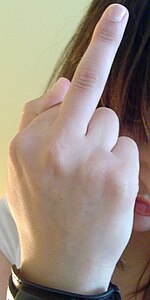竖中指

竖中指为手势之一,仅伸中指一指而其他指下压。当一个人对着另一个人面前做出中指手势时在粤语中俗称畀中指(英语:giving someone the middle finger,或写作比中指或俾中指[a]),而把中指手势抬高向他人示意时则俗称举中指。因为该手势广泛流传,常被人戏称为“国际友好手势”。
起源
[编辑]中指的手势在古希腊可指鸡奸,用来鄙视、恐吓或威胁他人。[1]也能指阴茎,同时旁边的手指为睾丸。[2]或许,这一举动还可能作避邪的效用。[3]在一世纪的地中海地区,伸直手指还是许多用来转移无时不在的恶魔之眼注意的方法之一。[4]
在希腊语中这个手势叫做“katapugon”[5][6] (“κατάπυγον”,由“kata”- κατά,“向下”[7]和“pugē” - πυγή,“臀部”组成[8])。在古希腊喜剧,这手势还是对人的侮辱,因“katapugon”同样说一个接受鸡奸的男人[9]或者katapugaina一个女人。[10]在亚里斯多芬尼斯(Aristophanes)的喜剧The Clouds(423 BC)里[11],当剧中角色Socrates问学生韵律时,Strepsiades声称他十分了解强弱弱格(dactyl),并比出了中指。这手势说希腊语词“dactylos”的双关义:手指(dactyly);一种由一声长和两声短的格律(像手指的关节— ‿ ‿ ——这在中世纪的拉丁文中也是阴茎睾丸的双关)[12])。Socrates对此反应很剧烈。[11][13]这个手势在Peace中作为嘲笑再次出现。[14][15]之后它的用法在Suda得到解释。[16][17]词组“to play the Siphnian”出现在亚里斯多芬尼斯的一个片段中,也有类似的意义。[18][19]在Suda中这个用法又有解释,据说是“用手指摸肛门”的意思。[20]第欧根尼·拉尔修(Diogenes Laertius)记录了犬儒学派的哲学家第欧根尼在公元前4世纪的雅典是如何对演说家德摩斯梯尼比出手势的。[21]在Discourses of Epictetus中,第欧根尼的对象则是另外一个诡辩家。[22]
一个广为流传,关于竖中指手势的起源的讹传:在英法百年战争后期的阿金科特战役,英格兰长弓兵让法军损失惨重,法军发誓在击败英军后,将英军弓箭手拉弓的中指斩断。但结果法军惨败。在法军撤退时,英军弓箭手纷纷伸出右手中指,炫耀他们依然存在的中指。以上关于竖中指的起源叙述是不正确的。[23]
在古罗马,这个手势称为“digitus impudicus”,一种来侮辱别人手势。
在加拿大,前总理皮埃尔·特鲁多对反对者使用这个手势后,竖中指被称为“特鲁多问候”(Trudeau salute)。
类似手势
[编辑]在日本手语、台湾手语、韩国手语等日本手语系的手语中,双手竖中指手势代表兄弟,而手的移动方向则表示具体是“哥哥”还是“弟弟”[24][25]。
相关条目
[编辑]注解
[编辑]- ^ “畀”的意思是“给予”(英语:giving),但中文里通常将之换为通假字“比”或“俾”,而变成“比中指”或“俾老二”。
参考文献
[编辑]- ^ Oricchio, Michael. Davis' Infamous Finger Salute Has Had a Big Hand in History; Folklorists: Roots Go Back At Least 2,000 Years To Ancient Rome. San Jose Mercury News. 1996-06-20: 16A [2012-07-09]. (原始内容存档于2013-05-11).

- ^ Nasaw, Daniel. When did the middle finger become offensive?. BBC News Magazine (BBC). 2012-02-06 [2012-02-07]. (原始内容存档于2012-02-06).
- ^ Corbeill, Anthony. Nature Embodied: Gesture in Ancient Rome. Princeton University Press. 2003: 6 [2013-10-04]. ISBN 978-0-691-07494-8. (原始内容存档于2020-11-04).
- ^ Malina, Bruce J. The New Testament World: Insights from Cultural Anthropology 3. Louisville: Westminster John Knox Press. 2001.
- ^ Liddell, Henry George; Robert Scott. A Greek–English Lexicon: κατάπυγον. Oxford University Press (via Perseus Project). 1940 [2012-07-11]. (原始内容存档于2020-11-12).
- ^ Halperin, David M.; Winkler, John J. Before Sexuality: The Construction of Erotic Experience in the Ancient Greek World. Princeton University Press. 1992: 186 [2013-10-04]. ISBN 978-0-691-03538-3. (原始内容存档于2013-12-14).
- ^ Liddell, Henry George; Robert Scott. A Greek–English Lexicon: κατά. Oxford University Press (via Perseus Project). 1940 [2012-07-11]. (原始内容存档于2012-05-13).
- ^ Liddell, Henry George; Robert Scott. A Greek–English Lexicon: πυγή. Oxford University Press (via Perseus Project). 1940 [2012-07-11]. (原始内容存档于2021-03-07).
- ^ Cohen, Beth. Not the classical ideal: Athens and the construction of the other in Greek art. Brill. 2000: 186.
- ^ Calame, Claude; Lloyd, Janet. The Poetics of Eros in Ancient Greece. Princeton University Press. 1999: 136 [2013-10-04]. ISBN 978-0-691-04341-8. (原始内容存档于2014-10-11).
- ^ 11.0 11.1 Dover, K.J. Aristophanes Clouds. Oxford University Press. 1968: xvii, 181. ISBN 0-19-814395-8.
- ^ Adams, J.N. The Latin Sexual Vocabulary. Johns Hopkins University Press. 1982: 39.
- ^ Aristophanes. Clouds (ll. 650-6). Perseus Project. [2012-07-11]. (原始内容存档于2021-03-07).
- ^ Aristophanes. Peace (ll. 546-9). Perseus Project. [2012-07-17]. (原始内容存档于2021-03-07) (grc).
- ^ Liddell, Henry George; Robert Scott. A Greek–English Lexicon: σκιμαλίζω. Oxford University Press (via Perseus Project). 1940 [2012-07-17]. (原始内容存档于2021-03-08).
- ^ Suda On Line: Ἐσκιμάλισεν. The Stoa Consortium. [2012-07-17]. (原始内容存档于2015-09-24).
- ^ Erasmus. Adages III.iii.87. University of Toronto Press. 1992: 311 [2013-10-04]. ISBN 978-0-802-02831-0. (原始内容存档于2013-10-07).
- ^ Liddell, Henry George; Robert Scott. A Greek–English Lexicon: σιφνιάζω. Oxford University Press (via Perseus Project). 1940 [2012-07-17]. (原始内容存档于2021-01-23).
- ^ Henderson, Jeffrey. The Maculate Muse: Obscene Language in Attic Comedy. Yale University Press. 1975: 213 [2013-10-04]. ISBN 978-0-300-01786-1. (原始内容存档于2018-06-18).
- ^ Suda On Line: Σιφνιάζειν. The Stoa Consortium. [2012-07-17]. (原始内容存档于2015-09-24).
- ^ Diogenes Laertius. Lives of Eminent Philosophers VI.2.34. Perseus Project. [2012-07-11]. (原始内容存档于2021-03-08) (grc).
- ^ Arrian. Discourses of Epictetus III.2.i. Perseus Project. [2012-07-17]. (原始内容存档于2021-03-08).
- ^ False claim: “Middle finger” gesture derives from English soldiers at the Battle of Agincourt in 1415. Reuters. 2020-05-14 [2022-06-23]. (原始内容存档于2022-07-13) (英语).
- ^ 神奈川県. 手話による「家族編」. 神奈川県. [2019-10-25]. (原始内容存档于2019-10-25) (日语).
- ^ TVBS. 〈獨家〉「指」點迷津 中指上下=台版手語「兄弟」│TVBS新聞網. TVBS. [2019-10-25]. (原始内容存档于2019-10-25) (中文(台湾)).
